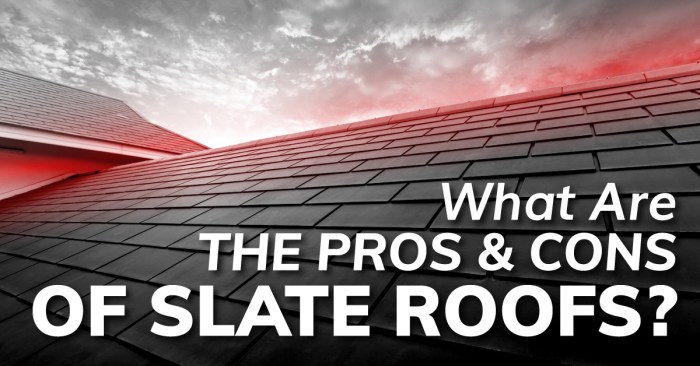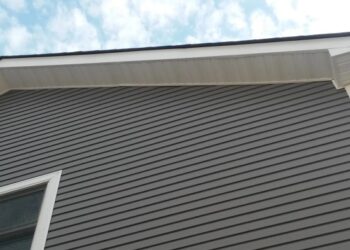Delving into the world of slate roofing pros and cons, this paragraph sets the stage for a comprehensive look at the advantages and disadvantages of this roofing material.
Exploring the durability, aesthetic appeal, and eco-friendliness of slate roofs, this discussion aims to provide valuable insights for those considering this option.
Pros of Slate Roofing
Slate roofing offers numerous advantages that make it a popular choice for homeowners. Let's explore some of the key benefits:
Durability of Slate Roofing
One of the most significant advantages of slate roofing is its exceptional durability. Slate is a natural stone material that can last for decades, even centuries, when properly maintained. Unlike other roofing materials that may deteriorate over time, slate is known for its longevity and ability to withstand harsh weather conditions.
Aesthetic Appeal of Slate Roofs
In addition to being durable, slate roofs are also highly prized for their timeless beauty and elegant appearance. The natural variations in color and texture of slate tiles create a unique and sophisticated look that adds value to any home.
Whether in traditional or modern architectural styles, slate roofing enhances the overall aesthetic appeal of a property.
Eco-Friendly Aspects of Using Slate
Another advantage of slate roofing is its eco-friendly nature. Slate is a natural, sustainable material that is harvested from quarries and requires minimal processing. This makes it a more environmentally friendly choice compared to synthetic roofing materials. Additionally, the long lifespan of slate roofs means less waste over time, reducing the environmental impact of roof replacements.
Cons of Slate Roofing
Installing a slate roof comes with its own set of challenges and drawbacks. Let's take a closer look at some of the disadvantages of choosing slate roofing.
Weight Considerations
Slate is a heavy material, much heavier than other roofing options such as asphalt shingles or metal. This means that the structure of your home must be able to support the weight of a slate roof. If your home is not built to handle this extra weight, costly reinforcements may be necessary.
Cost Implications
Slate roofing is known for its high upfront costs. The price of slate tiles themselves is significantly higher than other roofing materials, and the installation process can also be more labor-intensive. While the longevity of slate may offset some of these costs over time, the initial investment can be a deterrent for many homeowners.
Maintenance Requirements
Compared to materials like asphalt shingles or metal roofing, slate requires more maintenance to ensure its longevity. Regular inspections and repairs are necessary to prevent issues such as cracked or broken tiles. Additionally, finding a contractor with experience in working with slate can be more challenging, potentially leading to higher maintenance costs.
Installation of Slate Roofs

When it comes to installing slate roofs, it is essential to follow a specific process to ensure durability and proper functionality. Below is a step-by-step guide on how slate roofs are typically installed, along with a comparison to other roofing materials and the expertise required for this task.
Step-by-Step Guide for Installing Slate Roofs
- Preparation of the Roof Deck: The existing roof material is removed, and the roof deck is inspected and repaired if needed to provide a stable base for the slate tiles.
- Installation of Underlayment: A waterproof underlayment is installed over the roof deck to protect the structure from water infiltration.
- Setting the Eaves: Metal flashing is installed along the eaves to prevent water from seeping into the roof structure.
- Installing the Slate Tiles: Each slate tile is individually nailed to the roof deck, starting from the bottom and working upwards in overlapping rows.
- Securing the Ridge: Ridge tiles are installed along the peak of the roof to provide a finished look and additional protection.
- Final Inspection: The roof is inspected to ensure all tiles are properly installed and any necessary adjustments are made.
Comparison to Other Roofing Materials
Compared to other roofing materials such as asphalt shingles or metal roofing, installing slate roofs is a more labor-intensive and time-consuming process. The individual placement of each slate tile requires precision and skill, making it a specialized job that may take longer to complete.
Expertise Required for Installing Slate Roofs
Installing slate roofs requires a high level of expertise and craftsmanship. Roofers must have experience working with natural slate tiles and be familiar with the specific installation techniques to ensure a watertight and long-lasting roof. Due to the delicate nature of slate tiles, proper handling and installation are crucial to prevent breakage and ensure the integrity of the roof.
Longevity and Maintenance
When it comes to the longevity of roofing materials, slate stands out as one of the most durable options available. Its natural properties make it resistant to weathering and deterioration compared to other materials like asphalt shingles or wood.
Longevity of Slate Roofs
- Slate roofs can last anywhere from 75 to 100 years, and in some cases even longer, with proper maintenance.
- The longevity of slate roofs is unmatched by most other roofing materials, making it a cost-effective option in the long run.
Maintenance Practices for Slate Roofs
- Regular inspections are crucial to identify any damaged or missing slates that need replacement.
- Clearing debris and keeping gutters clean will prevent water accumulation and potential damage to the roof.
- Applying a sealant or coating can help enhance the waterproofing and longevity of the slate roof.
Common Issues with Maintaining Slate Roofs
- Slates may become loose or crack over time, requiring immediate attention to prevent leaks.
- Moss or algae growth can occur on the surface of the slates, which should be cleaned to prevent damage.
- Improper installation or repairs can lead to issues down the line, so it's essential to hire experienced professionals for maintenance work.
Final Thoughts
In conclusion, the discussion on slate roofing pros and cons highlights the key factors to consider when choosing this type of roofing material. Whether you prioritize longevity, maintenance, or cost, understanding these aspects can help you make an informed decision for your home.
FAQ Section
What is the average lifespan of a slate roof?
Slate roofs can last anywhere from 75 to 200 years, making them one of the longest-lasting roofing materials available.
Is slate roofing suitable for all types of climates?
Slate roofing is best suited for moderate to cold climates, as extreme heat can sometimes cause the slate to deteriorate over time.
How does the cost of slate roofing compare to other materials?
Slate roofing tends to be more expensive upfront, but its durability and longevity often make it a cost-effective choice in the long run.











